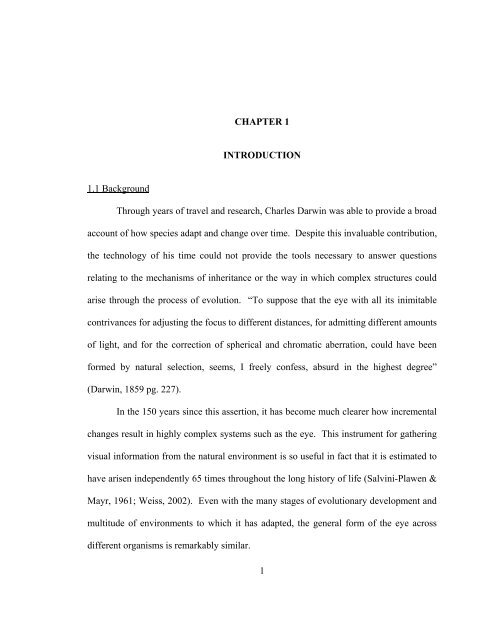modern variation and evolutionary change in the hominin eye orbit
modern variation and evolutionary change in the hominin eye orbit
modern variation and evolutionary change in the hominin eye orbit
You also want an ePaper? Increase the reach of your titles
YUMPU automatically turns print PDFs into web optimized ePapers that Google loves.
CHAPTER 1INTRODUCTION1.1 BackgroundThrough years of travel <strong>and</strong> research, Charles Darw<strong>in</strong> was able to provide a broadaccount of how species adapt <strong>and</strong> <strong>change</strong> over time. Despite this <strong>in</strong>valuable contribution,<strong>the</strong> technology of his time could not provide <strong>the</strong> tools necessary to answer questionsrelat<strong>in</strong>g to <strong>the</strong> mechanisms of <strong>in</strong>heritance or <strong>the</strong> way <strong>in</strong> which complex structures couldarise through <strong>the</strong> process of evolution. “To suppose that <strong>the</strong> <strong>eye</strong> with all its <strong>in</strong>imitablecontrivances for adjust<strong>in</strong>g <strong>the</strong> focus to different distances, for admitt<strong>in</strong>g different amountsof light, <strong>and</strong> for <strong>the</strong> correction of spherical <strong>and</strong> chromatic aberration, could have beenformed by natural selection, seems, I freely confess, absurd <strong>in</strong> <strong>the</strong> highest degree”(Darw<strong>in</strong>, 1859 pg. 227).In <strong>the</strong> 150 years s<strong>in</strong>ce this assertion, it has become much clearer how <strong>in</strong>cremental<strong>change</strong>s result <strong>in</strong> highly complex systems such as <strong>the</strong> <strong>eye</strong>. This <strong>in</strong>strument for ga<strong>the</strong>r<strong>in</strong>gvisual <strong>in</strong>formation from <strong>the</strong> natural environment is so useful <strong>in</strong> fact that it is estimated tohave arisen <strong>in</strong>dependently 65 times throughout <strong>the</strong> long history of life (Salv<strong>in</strong>i-Plawen &Mayr, 1961; Weiss, 2002). Even with <strong>the</strong> many stages of <strong>evolutionary</strong> development <strong>and</strong>multitude of environments to which it has adapted, <strong>the</strong> general form of <strong>the</strong> <strong>eye</strong> acrossdifferent organisms is remarkably similar.1
















